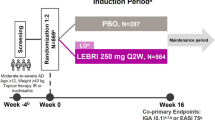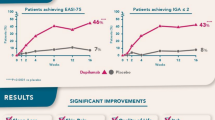Abstract
Allergic rhinitis may significantly affect the patients’ quality of life. The aim of this study was to compare the effects of nasal steroids alone, to nasal steroids plus Levocetirizine or Montelukast, on quality of life in persistent allergic rhinitis. This is a prospective, randomized study and included 56 patients with moderate to severe persistent allergic rhinitis. All patients had house dust mite allergy on skin prick test and we divided the patients into three groups. 1 month long medical treatment was; topical Mometasone furoate 200 mcg/day in the first group (n:14), Mometasone furoate 200 mcg/day plus oral Levocetirizine 5 mg/day in the second group (n:21), and Mometasone furoate 200 mcg/day plus oral Montelukast 10 mg/day in the third group (n:21). We evaluated the patients before treatment and at the first month after treatment with mini rhinoconjunctivitis quality of life questionnaire (miniRQLQ) and nasal symptom scores. In the first group nasal symptom and mini RQLQ scores were not improved but in second and third group, both scores were improved significantly (p < 0.05). Nasal obstruction symptom score was better in the third group after treatment (p < 0.01), but other nasal symptom scores (rhinorrhea, sneezing and nasal itching) were better in the second group (For each symptom p < 0.05). Improvement of quality of life scores in the second group were better than the third group (p < 0.05). In persistent allergic rhinitis, combination of levocetirizine or montelukast to nasal steroids was better than the topical mometasone furoate alone in terms of quality of life.


Similar content being viewed by others
References
Lundback B (1998) Epidemiology of rhinitis and asthma. Clin Exp Allergy 28(Suppl 2):3–10
Bousquet J et al (2008) Allergic rhinitis and its impact on asthma(ARIA) 2008 update. Allergy 63(86):8–160
Pulleritis T, Praks L, Skoogh BE, Ani R, Lotvall J (1999) Randomized placebo-controlled study comparing a leukotriene receptor antagonist and a nasal glucocorticoid in seasonal allergic rhinitis. Am J Respir Crit Care Med 159:1814–1818
Weiner JM, Abramson MJ, Puy RM (1998) Intranasal corticosteroids versus oral H1 receptor antagonists in allergic rhinitis: systematic review of randomised controlled trials. BMJ 317:1624–1629
Simons FE (2004) Advances in H1-antihistamines. N Engl J Med 351:2203–2217
Yanez A, Rodrigo GJ (2002) Intranasal corticosteroids versus topical H1 receptor antagonists for the treatment of allergic rhinitis: a systematic review with meta-analysis. Ann Allergy Asthma Immunol 89:479–484
Schenkel E (2003) Features of mometasone furoate nasal spray and its utility in the management of allergic rhinitis. Expert Opin Pharmacother 4:1579–1591
Bernstein DI, Levy AL, Hampel FC, Baidoo CA, Cook CK, Philpot EE et al (2004) Treatment with intranasal fluticasone propionate significantly improves ocular symptoms in patients with seasonal allergic rhinitis. Clin Exp Allergy 34:952–957
Berger WE, Nayak AS, Staudinger HW (2005) Mometasone furoate improves congestion in patients with moderatetor severe seasonal allergic rhinitis. Ann Pharmacother 39:1984–1989
Bhatia S, Baroody FM, de Tineo M, Naclerio RM (2005) Increased nasal airflow with budesonide compared with desloratadine during the allergy season. Arch Otolaryngol Head Neck Surg 131:223–228
Rosenblut A, Bardin PG, Muller B, Faris MA, Wu WW, Caldwell MF et al (2007) Long-term safety of fluticasone furoate nasal spray in adults and adolescents with perennial allergic rhinitis. Allergy 62:1071–1077
Brannan MD, Herron JM, Reidenberg P, Affrime MB (1995) Lack of hypothalamic-pituitary-adrenal axis suppression with once-daily or twicedaily beclomethasone dipropionate aqueous nasal spray administered to patients with allergic rhinitis. Clin Ther 17:637–647
Wilson AM, Sims EJ, McFarlane LC, Lipworth BJ (1998) Effects of intranasal corticosteroids on adrenal, bone, and blood markers of systemic activity in allergic rhinitis. J Allergy Clin Immunol 102:598–604
Kim KT, Rabinovitch N, Uryniak T, Simpson B, O’Dowd L, Casty F (2004) Effect of budesonide aqueous nasal spray on hypothalamic-pituitaryadrenal axis function in children with allergic rhinitis. Ann Allergy Asthma Immunol 93:61–67
Fokkens WJ, Jogi R, Reinartz S, Sidorenko I, Sitkauskiene B, van Oene C et al (2007) Once daily fluticasone furoate nasal spray is effective in seasonal allergic rhinitis caused by grass pollen. Allergy 62:1078–1084
Scadding GK (2004) Intranasal steroid sprays in the treatment of rhinitis is one better than another? J Laryngol Otol 118:395–396 author reply 6
Blaiss MS, Benninger MS, Fromer L, Gross G, Mabry R, Mahr T et al (2006) Expanding choices in intranasal steroid therapy: summary of a roundtable meeting. Allergy Asthma Proc 27:254–264
Wilson AM, O’Byrne PM, Parameswaran K (2004) Leukotriene receptor antagonists for allergic rhinitis: a systematic review and meta-analysis. Am J Med 116:338–344
Rodrigo GJ, Yanez A (2006) The role of antileukotriene therapy in seasonal allergic rhinitis: a systematic review of randomized trials. Ann Allergy Asthma Immunol 96:779–786
Nathan RA, Yancey SW, Yancey SW, Waitkus-Edwards K, Prillaman BA, Stauer JL, Philpot E (2005) Fluticasone propionat nasal spray is superior to montelukast for allergic rhinitis while neither affects overall asthma control. Chest 128:1910–1920
Martin BG, Andrews CP, van Bavel JH, Hampel FC, Klein KC, Prillaman BA et al (2006) Comparison of fluticasone propionate aqueous nasal spray and oral montelukast for the treatment of seasonal allergic rhinitis symptoms. Ann Allergy Asthma Immunol 96:851–857
Patel P, Philip G, Yang W, Call R, Horak F, LaForce C et al (2005) Randomized, double-blind, placebo-controlled study of montelukast for treating perennial allergic rhinitis. Ann Allergy Asthma Immunol 95:551–557
Philip G, Williams-Herman D, Patel P, Weinstein SF, Alon A, Gilles L et al (2007) Efficacy of montelukast for treating perennial allergic rhinitis. Allergy Asthma Proc 28:296–304
Di Lorenzo G, Pacor ML, Pellitteri ME, Morici G, Di Gregoli A, Lo Bianco C (2004) Randomized placebo-controlled trial comparing fluticasone aqueous nasal spray in monotherapy, fluticasone plus cetirizine, fluticasone plus montelukast and cetirizine plus montelukast for seasonal allergic rhinitis. Clin Exp Allergy 34:259–267
Saengpanich S, de Tineo M, Naclerio RM, Baroody FM (2003) Fluticasone nasal spray and the combination of loratadine and montelukast in seasonal allergic rhinitis. Arch Otolaryngol Head Neck Surg 129:557–562
Pullerits T, Praks L, Ristioja V, Lotvall J (2002) Comparison of a nasal glucocorticoid, antileukotriene, and a combination of antileukotriene and antihistamine in the treatment of seasonal allergic rhinitis. J Allergy Clin Immunol 109:949–955
Author information
Authors and Affiliations
Corresponding author
Rights and permissions
About this article
Cite this article
Tatar, E.Ç., Sürenoğlu, Ü.A., Özdek, A. et al. The Effect of Combined Medical Treatment on Quality of Life in Persistent Allergic Rhinitis. Indian J Otolaryngol Head Neck Surg 65 (Suppl 2), 333–337 (2013). https://doi.org/10.1007/s12070-012-0486-9
Received:
Accepted:
Published:
Issue Date:
DOI: https://doi.org/10.1007/s12070-012-0486-9




